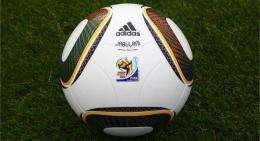Researchers Use Wind Tunnels to Test New World Cup Ball

Every four years, a new official soccer ball is designed for and used during World Cup matches. And every four years, players criticize the new ball.
"It's a little sad that the World Cup has ball of such poor quality," Iker Casillas of Spain, one of the top keepers in the world, told Spanish reporters after being scored upon in a match. Other players have called its flight weird and unpredictable.
But this time around, the athletes have science on their side.
Researchers in Japan were the first to independently test the ball's flight characteristics in wind tunnels, finding evidence that the new ball does in fact fly more erratically than the 2006 "Teamgeist" ball. Their data suggests it may not always provide the "exceptionally stable flight" that Adidas claims.
Some Balls Like It Rough
The new "Jabulani" ball -- released by Adidas last December in South Africa and in regular use since the beginning of the 2010 Major League Soccer season in March -- is not a traditional black-and-white ball of 32 flat pentagon and octagon panels stitched together.
The Jabulani is made of eight spherically-molded panels bonded together without stitches. Tested in computer simulations, wind tunnels, and on the pitch by Adidas personnel at a facility in Germany and by researchers at the University of Loughborough in the United Kingdom, the ball is, according to Adidas, "perfectly round" to within less than one hundredth of an inch.
English player Frank Lampard, who is sponsored by Adidas, described it as "a very strong ball, true to hit."
But some other sports engineers who have taken a look at the ball are inclined to agree with the goalkeepers. Its surface, they said, seems suspiciously smooth -- despite grooves added by the designers that encircle the ball.
"It seems like the aerodynamic characteristics of Jabulani come near that of a smooth sphere," said Takeshi Asai, a sports engineer who tested the new ball at the University of Tsukuba in Japan.
It sounds counterintuitive, but rougher balls tend to be more stable when flying through the air.
"If you had a golf ball without dimples, you couldn't drive it 100 yards," said John Eric Goff of the University of Virginia in Charlottesville. "If a baseball didn't have stitches, you'd never hit a home run."
That's because roughness on a surface creates turbulence around a ball moving at high speeds -- eddies of air that cling to and stabilize it. When a ball slows down to a critical speed, the airflow becomes smooth or "laminar" as the streamlines become parallel. This switch from turbulent to laminar flow, which roughness helps to counteract, causes the ball to change velocity; it's a nightmare for goalies and helps kickers bend one into the back of the net.
Decades of research have shown that the smallest variations in the surface can have a big effect. In 2008, Goff found that sharper faces on a traditional soccer ball help to trip the air flow to turbulent at lower speeds. Even the width of grooves on the surface of the ball has been shown to change the airflow.
Smooth Moves
The design of the ball may actually help it to fly farther at fast speeds, according to wind tunnel tests conducted by Kazuya Seo of Yamagata University in Japan, whose research was supported by the sports equipment manufacturer Molten USA. When kicked at 45-70 mph -- typical speeds achieved by professional players -- the ball feels less drag than previous balls and actually flies a few meters father.
But his tests also showed that as the ball slows, its behavior becomes more like that of a smooth sphere than previous World Cup balls. At just under 45 mph, turbulent flow becomes laminar and the ball suddenly feels heavy drag forces that put on the brakes.
"The fullback who wants to head the ball will have to wait more," said Seo. "The player who is familiar with the [2006] Geist might lose his/her timing."
Asai found another potential issue with the Jabulani in the wind tunnels: its spin.
Spinning balls -- like a curveball in baseball -- experience a sideward force noticed 300 years ago by Isaac Newton, who said that one side of tennis ball seems to "beat the contiguous air more vigorously than the other." This is now called the Magnus effect, and it happens because a spinning ball generates a pressure on one side is greater than on the other.
According to Asai's measurement, this sideways force on the Jabulani fluctuates more than the forces on the 2006 World Cup ball, which could cause it to bend in unpredictable ways and help to explain the reactions from goalkeepers.
Considering all of the other variables involved in the World Cup -- from pitches at high altitudes to inconsistent player performances -- it's unclear whether these differences in the ball in this are extreme enough to affect the final scores.
In the end, said Tim Chartier, a mathematician at Davidson College near Charlotte, N.C., putting out a new ball is a bit like Microsoft testing a new version of Windows in the field after months of laboratory debugging.
"World Cup soccer players will kick the ball again and again and again," said Cartier. "They'll find the unseen bugs."
Provided by Inside Science News Service


















